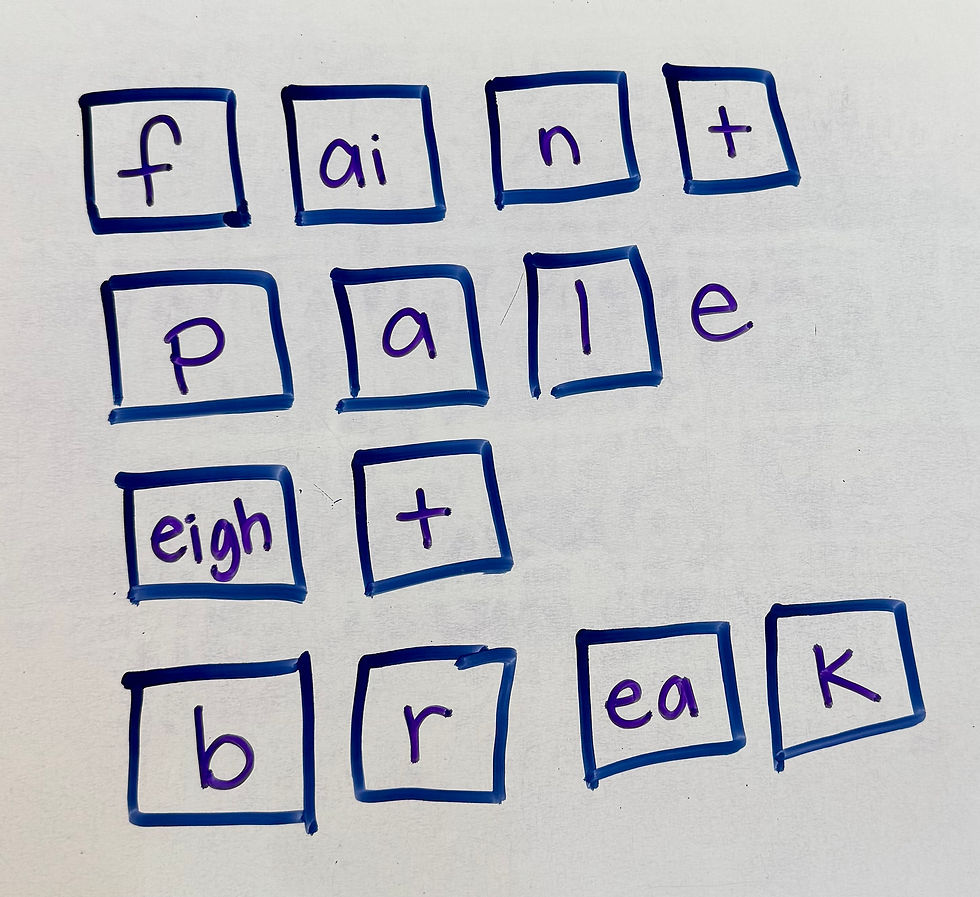Homework Tips: Conquering Weekly Spelling Lists
- Rebecca Bollar

- Oct 21
- 4 min read
Updated: Oct 31

S-P-E-L-L-I-N-G! Why This Matters More Than You Think
"When I grow up, all my writing will be on a computer with spell-check, so why do I even need to learn to spell?"
Sound familiar? More students are asking this question every year, and honestly—they're not entirely wrong. As adults, we do have constant access to spell-checking tools. But here's what they're missing: spelling isn't just about getting words right on paper.
Better spelling = Better reading
As literacy expert Richard Gentry explains, "Spelling literally ignites the reading and writing process."
When students learn to spell, they:
Decode unknown words faster (recognizing patterns helps with reading fluency)
Build stronger vocabulary (understanding word structure deepens meaning)
Write more fluently (automatic spelling frees up brain power for ideas)
While weekly spelling tests might feel tedious, they're building essential foundations for all literacy skills.
The Problem with Most Spelling Lists
Many weekly spelling lists fail because they emphasize memorization over understanding. I often see lists that look like a random grab bag of words with no connection to each other.
What makes a good spelling list:
Words are organized around sound patterns or word families
Focus on predictable spelling rules and generalizations
Clear teaching purpose (long vowels, silent letters, etc.)
What makes a bad spelling list:
Random assortment of words with no phonetic similarity
Words chosen thematically (Halloween words, weather words) without spelling connection
No clear pattern or rule is being taught
Don't worry! Even if your child's spelling list isn't perfectly organized, these strategies will help them succeed.
Strategy 1: Become Pattern Detectives 🔍
Day 1 of spelling practice should always start here.
Before any memorization begins, have your child read through the entire spelling list and play detective:

Ask these questions:
"Do you notice any similarities between these words?"
"What do you think your teacher is trying to teach you?"
"Can you group any of these words together?"
Then explicitly state the pattern or rule:
"These words all have the long 'a' sound spelled with 'ai'"
"All these words end in '-tion' and sound like 'shun'"
"These are compound words made of two smaller words"
When lists contain multiple rules or the same sound with multiple spelling patterns, sort the words into groups according to the rule.
Even if there's no clear pattern, this detective work gets your child thinking actively about word structure instead of just memorizing letter sequences.

Strategy 2: Flash Memory Training 💥
Best for: Spelling lists without clear patterns or irregular words
This strategy builds your child's visual memory bank for words.
You'll need: Paper, pencil, index cards with spelling words written on them
Setup:
Fold paper lengthwise to create 4 columns (2 front, 2 back)
Write each spelling word on a separate index card
The Process:
Show the word: Display one flashcard and discuss the word's "shape"
Point out tall letters (b, d, h, k, l, t)
Notice letters that hang below the line (g, j, p, q, y)
Identify doubled letters or unique features
Mental photograph: Tell your child to "take a picture" of the word with their eyes, then remove the card
Write from memory: Have them write the word in the first column while saying each letter name aloud
Quick check: Flash the card for less than 1 second and let them self-correct
Repeat: Move to the next 3 columns with the same word, then continue with remaining words
Flash: If your child loses their "mental picture," they can always ask for another quick flash of the word.
💡 Pro Tip: Make it Multisensory! Have the student write with a crayon or in a sandbox for tactile feedback.
Strategy 3: Sound Mapping 🗺️
Best for: Spelling lists that teach specific phonetic rules
This method helps students connect sounds to letters systematically.
You'll need: Paper with boxes drawn for each sound in the word
How it works:

Draw boxes: Create one box for each sound (not letter) in the word
Example: "train" = 4 boxes (t-r-ai-n)
Example: "light" = 3 boxes (l-igh-t)
Say and segment: Have your child say the word slowly, moving a finger under each box as they isolate each sound
Fill the boxes: Write the letter(s) that make each sound in the corresponding box
Practice the pattern: Use this method with all words that follow the same spelling rule
Example for words ending in -tion:
"action" = 4 boxes: [a] [c] [tion]
"nation" = 4 boxes: [n] [a] [tion]
This reinforces that "-tion" always sounds like "shun"
Strategy 4: The Testing Effect
Use this throughout the week, not just on Friday
Instead of just practicing writing words, test your child's recall regularly:
Daily mini-tests:
Monday: Practice 5 words using chosen strategy
Tuesday: Test Monday's words, practice 5 new ones
Wednesday: Test all 10 words, focus on missed words
Thursday: Final practice test, celebrate progress
Make it game-like:
"Let's see how many you can spell without looking!"
Keep track of improvement: "Yesterday you got 6 right, today you got 8!"
Focus on effort, not perfection
Strategy 5: Connect to Real Writing
Help your child see spelling words beyond the test:
Find words in books: "Look, there's one of your spelling words!"
Use in sentences: Have them create silly sentences using multiple spelling words
Write stories: Encourage them to use spelling words in creative writing
Real-world connections: Point out spelling words on signs, menus, or packaging

Action Plan
Choose the strategy that best fits your child's spelling list this week:
If the list has clear patterns: Start with Strategy 1 (Pattern Detective) then use Strategy 3 (Elkonin Boxes)
If the list seems random: Use Strategy 1 to look for any connections, then Strategy 2 (Visual Memory Training)
For all lists: Implement Strategy 4 (mini-tests throughout the week) instead of cramming Thursday night
👉 Remember: The goal isn't perfection on Friday's test—it's building spelling skills that transfer to reading and writing.




